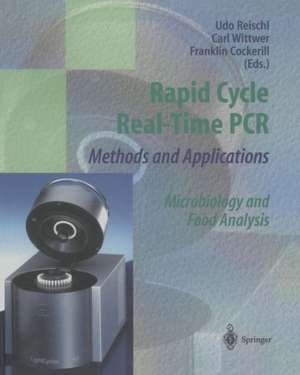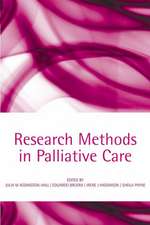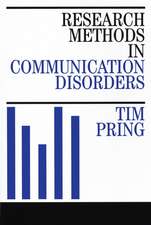Rapid Cycle Real-Time PCR — Methods and Applications: Microbiology and Food Analysis
Editat de U. Reischl, C. Wittwer, F. Cockerillen Limba Engleză Paperback – 12 dec 2012
Preț: 720.84 lei
Preț vechi: 758.77 lei
-5% Nou
Puncte Express: 1081
Preț estimativ în valută:
137.95€ • 149.79$ • 115.88£
137.95€ • 149.79$ • 115.88£
Carte tipărită la comandă
Livrare economică 22 aprilie-06 mai
Preluare comenzi: 021 569.72.76
Specificații
ISBN-13: 9783642483530
ISBN-10: 3642483534
Pagini: 272
Ilustrații: IX, 258 p.
Dimensiuni: 203 x 254 x 14 mm
Greutate: 0.54 kg
Ediția:Softcover reprint of the original 1st ed. 2002
Editura: Springer Berlin, Heidelberg
Colecția Springer
Locul publicării:Berlin, Heidelberg, Germany
ISBN-10: 3642483534
Pagini: 272
Ilustrații: IX, 258 p.
Dimensiuni: 203 x 254 x 14 mm
Greutate: 0.54 kg
Ediția:Softcover reprint of the original 1st ed. 2002
Editura: Springer Berlin, Heidelberg
Colecția Springer
Locul publicării:Berlin, Heidelberg, Germany
Public țintă
ResearchCuprins
for Microbiology Volume of Rapid Cycle Real-Time PCR.- Applications and Challenges of Real-Time PCR for the Clinical Microbiology Laboratory.- I Bacteriology.- Rapid Detection and Simultaneous Differentiation of Bordetella pertussis and Bordetella parapertussis in Clinical Specimens by LightCycler PCR.- Rapid Detection and Simultaneous Differentiation of Legionella spp. and L. pneumophila in Potable Water Samples and Respiratory Specimens by LightCycler PCR.- Homogeneous Assays for the Rapid PCR detection of Burkholderia pseudomallei 16s rRNA gene on a Real-Time Fluorometric Capillary Thermocycler.- Rapid Detection of Toxigenic Corynebacterium diphtheriae by LightCycler PCR.- Rapid Detection of Resistance Associated Mutations in Mycobacterium tuberculosis by LightCycler PCR.- Duplex LightCycler PCR Assay for the Rapid Detection of Methicillin-Resistant Staphylococcus aureus and Simultaneous Species Confirmation.- Rapid Detection of Group B Streptococci Using the LightCycler Instrument.- Rapid Detection and Quantification of Chlamydia trachomatis in Clinical Specimens by LightCycler PCR.- Quantification of Toxoplasma gondii in Amniotic Fluid by Rapid Cycle Real-Time PCR.- Genospecies-Specific Melting Temperature of the recA PCR Product for the Detection of Borrelia burgdorferi sensu lato and Differentiation of Borrelia garinii from Borrelia afzelii and Borrelia burgdorferi sensu stricto.- Rapid and Specific Detection of Coxiella burnetii by LightCycler PCR.- Molecular Identification of Campylobacter coli and Campylobacter jejuni Using Automated DNA Extraction and Real-Time PCR with Species-Specific TaqMan Probes.- Rapid and Specific Detection of Plesiomonas shigelloides Directly from Stool by LightCycler PCR.- Quantification of Thermostable Direct Hemolysin-Producing Vibrio parahaemolyticus from Foods Assumed to Cause Food Poisoning Using the LightCycler Instrument.- II Detection of Fungal Pathogens.- Quantification and Speciation of Fungal DNA in Clinical Specimens Using the LightCycler Instrument.- III Virology.- Development, Implementation, and Optimization of LightCycler PCR Assays for Detection of Herpes Simplex Virus and Varicella-Zoster Virus from Clinical Specimens.- Qualitative Detection of Herpes Simplex Virus DNA in the Routine Diagnostic Laboratory.- Use of Real-Time PCR to Monitor Human Herpesvirus 6 (HHV-6) Reactivation.- Simultaneous Identification of Five HCV Genotypes in a Single Reaction.- Rapid Detection of West Nile Virus.- Use of Rapid Cycle Real-Time PCR for the Detection of Rabies Virus.- Development of One-Step RT-PCR for the Detection of an RNA Virus, Dengue, on the Capillary Real-Time Thermocycler.- IV Detection of Genetically Modified Organisms (GMO).- Variation Analysis of Seven LightCycler Based Real-Time PCR Systems to Detect Genetically Modified Products (RRS, Bt176, Bt11, Mon810, T25, Lectin, Invertase).
Textul de pe ultima copertă
Rapid Cycle Real-Time PCR is a powerful analytical tool with broad application for the basic and applied life sciences. Compared with conventional PCR technology, Rapid Cycle Real-Time PCR is faster, has greater specificity, and is more easily adaptable for a variety of diagnostic tests, including qualitative, quantitative and mutation detection assays. This book provides general overviews of this technology for use in the clinical microbiology laboratory as well as specific diagnostic protocols for the detection of viral, bacterial and fungal pathogens and genetically modified organisms in human specimens and foodstuffs. All of these protocols have been developed, verified, and validated by experts in the field and should be of great interested for clinical microbiologists, pathologists, laboratory technologists as well as practicing physicians.













